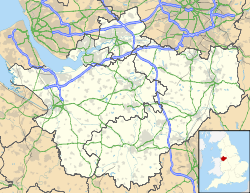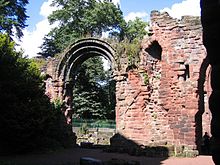- St John the Baptist's Church, Chester
-
St John the Baptist's Church, Chester 
St John the Baptist's Church, Chester, from the northeastLocation in Cheshire Coordinates: 53°11′20″N 2°53′08″W / 53.1890°N 2.8856°W OS grid reference SJ 409 661 Location Chester, Cheshire Country England Denomination Anglican Website Parish of Chester History Dedication John the Baptist Architecture Status Parish church Functional status Active Heritage designation Grade I Designated 28 July 1955 Architect(s) R.C. Hussey, John Douglas Architectural type Church Style Norman, Gothic, Gothic Revival Completed 1886 Specifications Materials Sandstone Administration Parish Chester, St Peter with St John Deanery Chester Archdeaconry Chester Diocese Chester Province York Clergy Rector Fr. David Chesters OBE Assistant priest Revd. Canon Tony Boyd Laity Reader Keith Allen Organist(s) Mary Lees Churchwarden(s) Alan Lees, David Rogers St John the Baptist's Church, Chester is in the city of Chester, Cheshire, England. It lies outside the city walls on a cliff above the north bank of the River Dee.[1] It has been designated by English Heritage as a Grade I listed building.[2] It is an active Anglican parish church in the diocese of Chester, the archdeaconry of Chester and the deanery of Chester. Its benefice is combined with that of St Peter, Chester.[3] Alec Clifton-Taylor includes it in his list of 'best' English parish churches,[4] and it is considered to be the best example of 11th–12th century church architecture in Cheshire.[2]
Contents
History
The church was reputedly founded by King Aethelred in 689.[5] During the 11th century, Earl Leofric was a "great benefactor" of the church.[6] In 1075 Peter, Bishop of Lichfield moved the seat of his see to Chester, making St John's his cathedral until he died in 1085.[7] Peter's successor moved his seat to Coventry[1] and St John's became a co-cathedral.[2] The building of the church continued on a large scale until the end of the 13th century and continued as a collegiate church of secular canons.[1] After the Dissolution, much of the east end of the church was demolished and some of it remains as ruins to the east of the present church.[8] Since the Dissolution, it has been a parish church.[2]
In 1468 the central tower collapsed. In 1572 the northwest tower partially collapsed and in 1574 there was a greater collapse of this tower which destroyed the western bays of the nave. This was rebuilt on a "magnificent scale".[9] There were restorations to the church in 1859–66 and 1886–87 by R. C. Hussey.[8] While the northwest tower was being repaired in 1881 it collapsed again, this time destroying the north porch. The porch was rebuilt in 1881–82 by John Douglas.[9] John Douglas also built the northeast belfry tower in 1886.[2] In 1925 the chapel at the south east corner, then the Warburton chapel, was extended to form a Lady Chapel.[1]
Architecture
Exterior
The church is built in sandstone. At the west end is the ruined first stage of the northwest tower. The plan of the body of the church consists of a four-bay nave with a clerestory, north and south aisles and a north porch, a crossing with north and south transepts each of one bay, a five-bay chancel with aisles, and chapels at the north and south. The north chapel lies beneath the 1886 belfry tower and is now used as a vestry; the south chapel is the Lady Chapel. To the south of the Lady Chapel is a room known as the Chapter House.[2]
Interior
While the external fabric of the church is largely Early English in style due to the Victorian restorations, much of the interior consists of Norman material.[9] This is present in the nave, the crossing, the first bay of the chancel, the arch to the Lady Chapel and in the remains of the choir chapels.[10] Richards considers that that it is the best masonry of the Norman period in Cheshire.[1] Inside the church are many early effigies which are all damaged, some dating back as far as the late 13th or early 14th century.[1][2] Monuments to the Warburton family are in the Lady Chapel. In the church are two fonts, one dating from the 15th century, the other from the Commonwealth period. Two brass chandeliers are dated 1722.[1] The pulpit is from the 19th century. The reredos, dated 1876, is by John Douglas and was made by Morris & Co.; it includes a painting of the Last Supper.[2] The organ had been built as a temporary organ for the coronation of Queen Victoria in 1838 by William Hill and Company of London. It was then rebuilt for St John's, transported to Chester by barge and installed in the west gallery. In the 1859–66 restoration it was moved to the south transept and in 1895–96 it was moved to the north transept. In the 1960s it was converted to electro-pneumatic action by Charles Whiteley and Company. In 2002 it was restored following vandalism by Rod Billingsley.[clarification needed][11] The organ case dated 1895 is by Thomas M. Lockwood. A memorial to Lockwood is in the north aisle. The stained glass in the east window dated 1863 was designed by T. M. Penson and made by Clayton and Bell. The west window was designed by Edward Frampton and is dated 1887–1890. In the north aisle is a barely visible wall painting of St John the Baptist.[10] The church contains nine memorial boards by members of the Randle Holme family.[12] Also inside the church are fragments of late Saxon stone crosses that are thought to have been originally in the churchyard.[13] The church plate includes two damaged pewter chalices and a paten from the late 12th or early 13th centuries and a number of silver items from the 17th and 18th centuries. The parish registers begin in 1559.[1]
External features
Outside the church to the east are ruined remains including parts of former chapels[8][9] which are recognised as a scheduled monument.[14][15]
The exterior of the church contains a few tombstones that remain in their original positions. The vast majority of the gravestones have now been repositioned and laid to the ground forming the footpaths immediately in front of the church. In 2009 a research project recorded the inscriptions on the remaining tombs and gravestones.[16]
See also
- Norman architecture in Cheshire
- Grade I listed buildings in Chester
- Scheduled Monuments in Cheshire (1066–1539)
- List of church restorations, amendments and furniture by John Douglas
References
- ^ a b c d e f g h Richards 1947, pp. 103–110.
- ^ a b c d e f g h "Church of St John the Baptist, Chester", The National Heritage List for England (English Heritage), 2011, http://list.english-heritage.org.uk/resultsingle.aspx?uid=1375977, retrieved 28 April 2011
- ^ Chester, St John the Baptist, Church of England, http://www.achurchnearyou.com/chester-st-john-the-baptist/, retrieved 3 October 2009
- ^ Clifton-Taylor 1974, p. 147
- ^ Ward 2009, p. 24.
- ^ Ward 2009, p. 30.
- ^ Ward 2009, p. 43.
- ^ a b c Salter 1995, pp. 30–31.
- ^ a b c d St John the Baptist, Chester, Corpus of Romanesque Sculpture of Great Britain and Ireland, http://www.crsbi.ac.uk/search/county/site/ed-ch-chsjb.html, retrieved 13 June 2010
- ^ a b Pevsner & Hubbard 2003, pp. 148–150.
- ^ Chester, St John the Baptist, British Institute of Organ Studies, http://www.npor.org.uk/cgi-bin/Rsearch.cgi?Fn=Rsearch&rec_index=N04296, retrieved 10 August 2008
- ^ Morant 1989, pp. 120–121.
- ^ Langtree & Comyns 2001, p. 35.
- ^ Pastscape: Church of St John the Baptist, English Heritage, http://www.pastscape.org.uk/hob.aspx?hob_id=69148, retrieved 5 April 2009
- ^ "St John's Church (ruined portions)", The National Heritage List for England (English Heritage), 2011, http://list.english-heritage.org.uk/resultsingle.aspx?uid=1006779, retrieved 28 April 2011
- ^ Gravestone Inscriptions at St. John the Baptist Parish Church, Chester, Cheshire, England., Historical Gems, http://www.historicalgems.co.uk/Gravestones-St-Johns-Chester%282363808%29.htm, retrieved 3 April 2011
- Bibliography
- Clifton-Taylor, Alec (1974), English Parish Churches as Work of Art, London: Batsford, ISBN 0-7134-2776-0
- Langtree, Stephen; Comyns, Alan, eds. (2001), 2000 Years of Building: Chester's Architectural Legacy, Chester: Chester Civic Trust, ISBN 0-9540152-0-7
- Morant, Roland W. (1989), Cheshire Churches, Birkenhead: Countyvise, ISBN 0-907768-18-0
- Pevsner, Nikolaus; Hubbard, Edward (2003) [1971], The Buildings of England: Cheshire, New Haven: Yale University Press, ISBN 0-300-09588-0
- Richards, Raymond (1947), Old Cheshire Churches, London: Batsford
- Salter, Mark (1995), The Old Parish Churches of Cheshire, Malvern: Folly Publications, ISBN 1-871731-23-2
- Ward, Simon (2009), Chester: A History, Chichester: Phillimore, ISBN 978-1-86077-499-7
External links
 Media related to St John's Church, Chester at Wikimedia CommonsCategories:
Media related to St John's Church, Chester at Wikimedia CommonsCategories:- Church of England churches in Cheshire
- Grade I listed churches
- Grade I listed buildings in Cheshire
- Norman architecture
- English Gothic architecture
- Gothic Revival architecture in Cheshire
- Ruins in Cheshire
- Buildings and structures in Chester
- John Douglas buildings
- Diocese of Chester
- Scheduled Ancient Monuments in Cheshire
Wikimedia Foundation. 2010.


